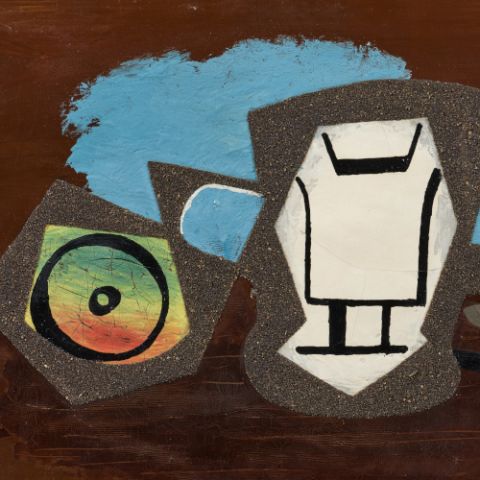
Lot 27 | Pablo Picasso | Femme tenant un journal
1881 Malaga - 1973 Mougins
Title: Femme tenant un journal.
Date: 1915.
Technique: Pencil on paper.
Measurement: 17,5 x 11cm.
Notation: Signed upper right: Picasso.
Frame/Pedestal: Framed. Not examined out of the frame.
Provenance:
- Konrad Klapheck Collection, Düsseldorf
- Private collection Germany
Literature:
- Zervos, Christian: Pablo Picasso - Vol. 2,2, Works from 1912 to 1917, Paris 2013, cat. rais. no. 861, ill.
- Early drawing by the exceptional artist, in which the essential characteristics of Cubism manifest themselves
- Created at a time when Cubism was at its peak
- From the former previous possession of Konrad Klapheck
Liberation from form and space
During the First World War, Pablo Picasso was left alone in Paris. His fellow artists Georges Braque and André Derain, who, along with himself, were among the main representatives of Cubism, were drafted into military service, while his German art dealer Daniel-Henry Kahnweiler had to leave France. This turning point in 1915 marked a departure from Cubism and a transition to a classical style (Fig. 1). In the meantime, the concept of Cubism had been adopted in a modified form by some artists, such as Fernand Léger and Robert Delaunay. Picasso distanced himself from the mannered style of these “salon Cubists”.
With Cubism, Picasso had revised the prevailing view since the Renaissance, according to which reality was reproduced as a true-to-life image based on the uniformity of perspective in favor of creating the greatest possible similarity. His pioneering work “Demoiselles d'Avignon” from 1907, which is considered a key work of classical modernism, already reflected Picasso's Cubist understanding of form, as the figures were dissolved into geometric facets. Due to these epochal innovations, the first Picasso retrospective in Germany took place as early as 1913 at the Munich gallery of Heinrich Thannhauser, and was subsequently shown in Prague and Berlin.
Floating dynamics of rhythmicized forms
The drawing Femme tenant un journal from 1915 manifests the essential characteristics of Cubism's pictorial approach, with which Picasso systematically broke with the traditional relationship between figure and space and brought about its detachment from traditional art. The artist viewed the depicted object from different points of view and combined multi-perspective views in the surface. The negation of a single vanishing point and the inevitable deformation of the figure that went with it meant a radical departure from illusionistic deception, which Picasso ultimately dismantled as a construct.
The figure of the lady sitting in a chair, holding a magazine in her hand, is neither placed in a unified spatial structure nor does she exhibit a closed body volume. Rather, she is fanned out in graphically distinct pictorial elements that fill the pictorial space like staggered layers in a loose arrangement. Although stronger pencil hatching within the clear contours models and simulates a physicality, this fragmented form does not establish a relationship with the surroundings. Instead of enabling a sense of place, the prismatically shifting linear structure of the cubic splinters develops its own floating dynamics, detached from the perspectival order. Without a foothold, without support, the viewer is carried by a formal rhythm in which diverse aspects of the appearance are combined in a multitude of vibrating, mutually permeating components.
Bettina Haiss.
Print this lot | Recommend lot |
Conditions of this Lot
32% buyer’s premium on the hammer price
Estimated shipping costs for this lot:
Arrangement after the auction.
Pablo Picasso Spain Cubism Surrealism Modern Art 1910s Framed. Not examined out of the frame Abstract Works on paper Pencil Figure / Figures
More lots which could be of your interest
- Estimate: 5.000 - 7.000 €Starting price : 5.000 €0 Bid(s)08T 15h:54m:48sModern Art | ONLINE ONLY | Auction 06.11.2025






